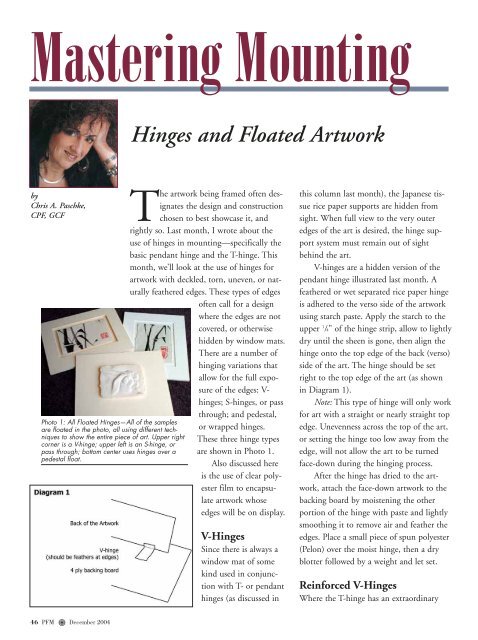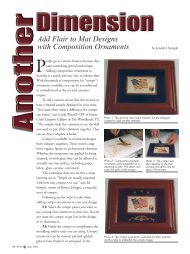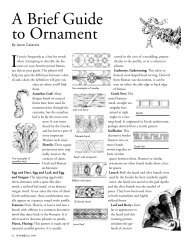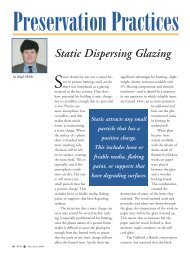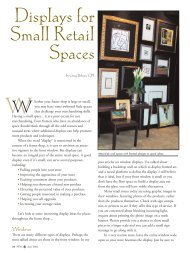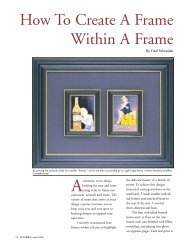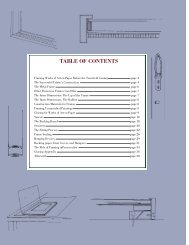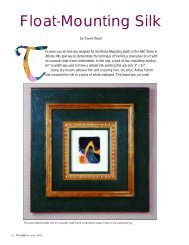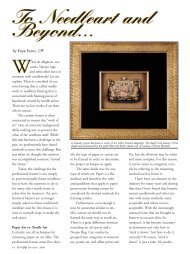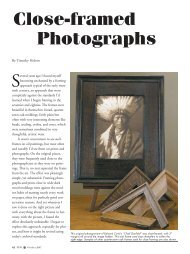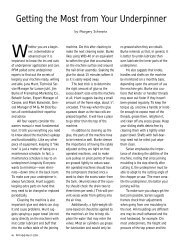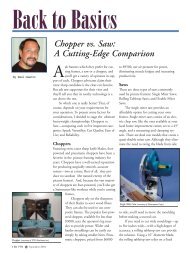Hinges and Floated Artwork - Picture Framing Magazine
Hinges and Floated Artwork - Picture Framing Magazine
Hinges and Floated Artwork - Picture Framing Magazine
You also want an ePaper? Increase the reach of your titles
YUMPU automatically turns print PDFs into web optimized ePapers that Google loves.
Mastering Mounting<br />
by<br />
Chris A. Paschke,<br />
CPF, GCF<br />
Photo 1: All <strong>Floated</strong> <strong>Hinges</strong>—All of the samples<br />
are floated in the photo, all using different techniques<br />
to show the entire piece of art. Upper right<br />
corner is a V-hinge; upper left is an S-hinge, or<br />
pass through; bottom center uses hinges over a<br />
pedestal float.<br />
46 PFM _ December 2004<br />
<strong>Hinges</strong> <strong>and</strong> <strong>Floated</strong> <strong>Artwork</strong><br />
The artwork being framed often designates<br />
the design <strong>and</strong> construction<br />
chosen to best showcase it, <strong>and</strong><br />
rightly so. Last month, I wrote about the<br />
use of hinges in mounting—specifically the<br />
basic pendant hinge <strong>and</strong> the T-hinge. This<br />
month, we’ll look at the use of hinges for<br />
artwork with deckled, torn, uneven, or naturally<br />
feathered edges. These types of edges<br />
often call for a design<br />
where the edges are not<br />
covered, or otherwise<br />
hidden by window mats.<br />
There are a number of<br />
hinging variations that<br />
allow for the full exposure<br />
of the edges: Vhinges;<br />
S-hinges, or pass<br />
through; <strong>and</strong> pedestal,<br />
or wrapped hinges.<br />
These three hinge types<br />
are shown in Photo 1.<br />
Also discussed here<br />
is the use of clear polyester<br />
film to encapsulate<br />
artwork whose<br />
edges will be on display.<br />
V-<strong>Hinges</strong><br />
Since there is always a<br />
window mat of some<br />
kind used in conjunction<br />
with T- or pendant<br />
hinges (as discussed in<br />
this column last month), the Japanese tissue<br />
rice paper supports are hidden from<br />
sight. When full view to the very outer<br />
edges of the art is desired, the hinge support<br />
system must remain out of sight<br />
behind the art.<br />
V-hinges are a hidden version of the<br />
pendant hinge illustrated last month. A<br />
feathered or wet separated rice paper hinge<br />
is adhered to the verso side of the artwork<br />
using starch paste. Apply the starch to the<br />
upper 1 /4" of the hinge strip, allow to lightly<br />
dry until the sheen is gone, then align the<br />
hinge onto the top edge of the back (verso)<br />
side of the art. The hinge should be set<br />
right to the top edge of the art (as shown<br />
in Diagram 1).<br />
Note: This type of hinge will only work<br />
for art with a straight or nearly straight top<br />
edge. Unevenness across the top of the art,<br />
or setting the hinge too low away from the<br />
edge, will not allow the art to be turned<br />
face-down during the hinging process.<br />
After the hinge has dried to the artwork,<br />
attach the face-down artwork to the<br />
backing board by moistening the other<br />
portion of the hinge with paste <strong>and</strong> lightly<br />
smoothing it to remove air <strong>and</strong> feather the<br />
edges. Place a small piece of spun polyester<br />
(Pelon) over the moist hinge, then a dry<br />
blotter followed by a weight <strong>and</strong> let set.<br />
Reinforced V-<strong>Hinges</strong><br />
Where the T-hinge has an extraordinary
potential for weight<br />
bearing with superior<br />
T-peel <strong>and</strong> shear<br />
strength, the Vhinge<br />
sacrifices that<br />
strength for being<br />
invisibly hidden<br />
behind the art. A Vhinge<br />
should always<br />
be reinforced with a<br />
horizontal crosspiece<br />
to prevent it from<br />
peeling off due to gravity <strong>and</strong>/or<br />
the weight of the art on which it is<br />
used (see Diagram 2).<br />
As with T-hinges, the reinforced<br />
horizontal strip applied<br />
over the adhered V-hinge may be<br />
made of rice paper, a pressure-sensitive<br />
tape approved for use with<br />
hinges, or a gummed paper tape<br />
(see Photo 2). Unlike the pendant<br />
hinge, these are often placed horizontally<br />
so the length of the hinge<br />
is pasted to the art, rather than<br />
vertically—with the width or narrowest<br />
portion attached to the art.<br />
S-<strong>Hinges</strong><br />
Whether called an S-hinge, pass<br />
through, folded, suspension tab, or<br />
concealed pendant hinge, this<br />
method is one that allows the art<br />
to visually float in the center of<br />
the frame. These hinges are<br />
mounted on one end to the back<br />
of the art while the other end is<br />
fed through the backing board <strong>and</strong><br />
mounted to the back of the<br />
mounting board (see Photo 3).<br />
The S-hinge is first mounted<br />
to the back side of the art <strong>and</strong><br />
allowed to dry. Slots are cut in the<br />
backing board at the proper position<br />
just slightly wider than the<br />
hinge. The sharp paper edges of<br />
the 4-ply board should be rounded<br />
to prevent cutting of the rice paper<br />
48 PFM _ December 2004<br />
Photo 2: V-Hinge—This hinge is similar to a pendant<br />
hinge (discussed last month) but is placed on<br />
the back of the art <strong>and</strong> folded back onto itself<br />
(left hinge). If reinforced with a crosspiece, it is<br />
drastically strengthened (right hinge).<br />
Photo 3: S-Hinge (or Pass Through)—The<br />
hinge is fitted through a slot that has been<br />
cut into the backing board to be affixed to<br />
the back of the mount board. This photo<br />
shows the hinge, already glued to the art<br />
with starch paste, after it has been fed<br />
through the prepared slot in the backing.<br />
hinges when they are being passed<br />
through, or otherwise h<strong>and</strong>led.<br />
Next, the hinges are fitted through<br />
the slots in the backing board (see<br />
Diagram 3) <strong>and</strong> glued to the back<br />
of the mount board, out of sight.<br />
As with the V-hinge described<br />
above, the basic S-hinge is subject<br />
to peel failure if the frame is rotated<br />
or mish<strong>and</strong>led <strong>and</strong> the weight of<br />
the art is allowed to pull against the<br />
hinge. Therefore, the S-hinge<br />
should be reinforced with a horizontal<br />
crosspiece as with the Thinge<br />
or the reinforced V-hinge.<br />
Jumbo <strong>Hinges</strong><br />
Another option to help reinforce a<br />
thin hinge is to create a jumbo<br />
hinge. The jumbo hinge is a bit of<br />
a hybrid in that it is a st<strong>and</strong>ard<br />
strip of mulberry rice paper that<br />
has been wet feathered 1" wide<br />
<strong>and</strong> 4" to 6" long. It is folded at<br />
its midpoint <strong>and</strong> glued together<br />
with starch paste—except for a 1 /4"<br />
section at each end—to create a<br />
double thick hinge. Those last 1 /4"<br />
ends are left unglued <strong>and</strong> flared<br />
out into a “T” shape for mounting<br />
to the art (see Photo 4).
Photo 4: Jumbo Hinge—The hinge to the<br />
right has been securely pasted to the backing<br />
as it would to the backing board when<br />
making an S-Hinge. The hinge laying<br />
beneath shows a readied pre-pasted jumbo<br />
hinge with its T-shaped flange ready to be<br />
mounted to the artwork.<br />
Jumbo hinges work well with<br />
the S-hinge technique because<br />
they reinforce the rice paper <strong>and</strong><br />
help prevent tearing at the actual<br />
pass through points of the 4-ply<br />
boards. Depending on the actual<br />
weight of the floated art, <strong>and</strong><br />
because of their added strength,<br />
jumbo hinges may not require a<br />
horizontal crosspiece to reinforce<br />
the hold.<br />
Pedestal <strong>Hinges</strong><br />
Pedestal, wrapped, or float hinges<br />
are all names for the same technique.<br />
This is a hinge process that<br />
allows free floating of artwork<br />
mounted to a raised pedestal or<br />
platform surface which is then<br />
fused to the backing board. Backing<br />
boards may be fabric covered<br />
or plain matboard, in any thickness<br />
from 4-ply to 1 /2", though 4ply<br />
<strong>and</strong> 8-ply are most common<br />
for preservation.<br />
The featured “Bunnies” sampler<br />
in Photo 5 is an open edition,<br />
3-D paper sculpture measuring<br />
4 1 /2"x4"x 1 /4". For the purpose of<br />
educational demonstration, the<br />
platform is a 3 /16" acid-free foamboard,<br />
rather than rag mat. The<br />
platform is reverse bevel cut small-<br />
50 PFM _ December 2004<br />
Photo 5: Pedestal Hinge—This is actually a work<br />
in progress shot prior to completion; hence the<br />
raw stacked foamboard deep bevel mat. The<br />
small 4 1 /2"x4"x 1 /4" three dimensional paper<br />
sculpture has been pedestal hinged for added<br />
depth. The foam mats still need to be wrapped<br />
<strong>and</strong> topped with a rag mat prior to fitting into<br />
this 9 1 /2"x9" Designer #49-13 gold metal frame.<br />
er than the art so it will not be<br />
seen from underneath, <strong>and</strong> the<br />
sharp corners of the bevel edges<br />
have been rounded to soften the<br />
sharp paper edge.<br />
To create the pedestal hinge,<br />
the hinge strips are pasted to the<br />
back of the art, weighted, <strong>and</strong><br />
allowed to dry. The dried hinges<br />
are then pasted around the<br />
smoothed edges of the top of the<br />
platform (see Diagram 4).<br />
<strong>Hinges</strong> may or may not be<br />
placed at the bottom or sides of a<br />
platform to help secure it, but<br />
never snugly, as the art must be<br />
allowed to move through natural<br />
expansion <strong>and</strong> contraction (see<br />
Photo 6). The hinges at the bottom<br />
of the sample are overkill on<br />
this piece because of its small size,<br />
but were a necessity on the original<br />
African mask painting on 100%<br />
kozo paper (see Photo 7).<br />
This piece was single matted<br />
with Alpharag 8675 Heather<br />
Brown <strong>and</strong> backed with the same.<br />
Modified Asian proportions were<br />
used for spacing at top <strong>and</strong> bottom<br />
of this 11"x31" artwork to help<br />
maintain the elongation of the<br />
Photo 6: Pedestal (or Wrapped) <strong>Hinges</strong> (back<br />
detail)—The top hinges are snug to the top edge<br />
of the platform. The hinges are loosely attached<br />
on the bottom to prevent the sculpture from<br />
pulling if turned over or inverted during h<strong>and</strong>ling.<br />
paper in this design. The detail<br />
corner of the mask as seen in<br />
Photo 8 shows the feathered <strong>and</strong><br />
deckled edges of the paper floated<br />
over an 8-ply Alpharag pedestal.<br />
This is placed in the deep frame<br />
with a 3 /8" spacer under the mat<br />
which was faced with matching<br />
Alpharag.<br />
This piece was completed with<br />
Tru Vue Conservation Clear glass,<br />
in a Larson-Juhl Java moulding<br />
lined with Lineco Rabbet Sealing<br />
Tape <strong>and</strong> finished with Lineco
acking paper. We must always<br />
remember that preservation framing<br />
means using accepted preservation<br />
materials <strong>and</strong> practices at<br />
every stage of the framing process.<br />
<strong>Floated</strong> Encapsulation<br />
Another option for framing an<br />
item for which you want to show<br />
all its edges is encapsulation.<br />
Encapsulation is the process of<br />
placing an image between two<br />
pieces of clear polyester film or<br />
archival quality polypropylene so<br />
that both sides may be viewed. By<br />
enclosing a delicate item in an<br />
envelope or between sheets with<br />
sealed edges, the art is supported,<br />
the mounting reversible, viewable<br />
from both sides, <strong>and</strong> may be floated<br />
to showcase the art to its outermost<br />
edges (see Photo 9).<br />
Encapsulated art may be<br />
backed with a contrasting color<br />
backing board or fabric for better<br />
viewing of irregular edges, or<br />
when there is no margin. As a<br />
design option, this format may<br />
also be used to allow for the framing<br />
to pick up the pattern of the<br />
wallpaper or faux finished wall<br />
behind it (see Photo 10). It may<br />
also be floated between two<br />
matching window mats in a rectoverso<br />
presentation simply to allow<br />
for viewing from both sides.<br />
The double window mat is<br />
hinged along the longest side of<br />
the mat unit with a gummed or<br />
pressure-sensitive flange hinge<br />
along the full length of the mat<br />
for better support (see Photo 11).<br />
This type of hinge is not considered<br />
a preservation format, but is<br />
used when it will not come in<br />
contact with the artwork.<br />
The clear film envelope is<br />
attached to the inner window by a<br />
52 PFM _ December 2004<br />
Photo 7: African<br />
Mask Painting—<br />
Shown here is a<br />
completed framed<br />
sample using the<br />
pedestal hinge<br />
technique. The art<br />
is mounted with<br />
wrapped hinges<br />
over an 8-ply<br />
pedestal. (Original<br />
artwork by Chris<br />
A. Paschke)<br />
pressure-sensitive flange hinge<br />
across the entire top to help keep<br />
the polyester from buckling. This<br />
process may be used more for<br />
archival storage than framing for<br />
wall display, unless it is to be double<br />
framed for viewing from both<br />
sides.<br />
What better way to end<br />
another year of framing than with<br />
two months of hinging review?<br />
Hopefully all of this is just a polishing<br />
of what you already know,<br />
but it is always good revisit <strong>and</strong><br />
confirm what we already know.<br />
Times change, as do materials <strong>and</strong><br />
practices. It’s not so very long ago<br />
we still used masking tape for<br />
hinging. I remember those days.<br />
Happy Holidays <strong>and</strong> a Happy<br />
New Year! n<br />
Chris A. Paschke, CPF, GCF,<br />
Mounting Editor, owns Designs Ink in<br />
Tehachapi, CA, featuring commercial custom<br />
framing, fine art/graphic design, <strong>and</strong><br />
industry consulting. Specializing in mounting,<br />
matting, design creativity, <strong>and</strong> fine art,<br />
she works with industry leaders <strong>and</strong> has<br />
taught for the National Conference. She<br />
has written two books on mounting: “The<br />
Mounting <strong>and</strong> Laminating H<strong>and</strong>book”<br />
(now in its second edition) <strong>and</strong> “Creative<br />
Mounting, Wrapping, <strong>and</strong> Laminating.”<br />
She can be contacted at<br />
www.designsinkart.com.<br />
Photo 8: Detail of African Mask Painting—This<br />
corner detail illustrates the floated nature <strong>and</strong><br />
depth of the framed art image.<br />
Photo 9: <strong>Floated</strong><br />
Encapsulation—By<br />
enclosing an item<br />
between two sheets of<br />
clear polyester film<br />
with sealed edges, the<br />
art may be floated so<br />
that all outer edges<br />
are visible. Notice the<br />
gray carpet underneath<br />
is visible behind<br />
the artwork.<br />
Photo 10: See Through<br />
Possibilities—Encapsulated<br />
art may be<br />
backed with a contrasting<br />
color backing<br />
board or may be used<br />
to allow for the framing<br />
to pick up the pattern<br />
behind it. The bamboo<br />
window shade in this<br />
photo shows the possibilities<br />
of using the pattern<br />
as part of the<br />
design.<br />
Photo 11: <strong>Floated</strong> Encapsulation with Open Mat—The<br />
double window mat is hinged along the longest side of<br />
the mat unit with gummed or pressure-sensitive linen<br />
tape as a flange hinge along the full length of the mat.<br />
Another flange runs across the top of the envelope with<br />
a paper tape.


